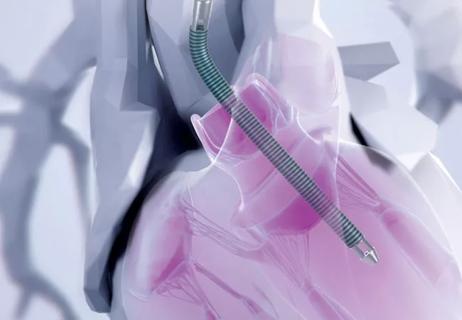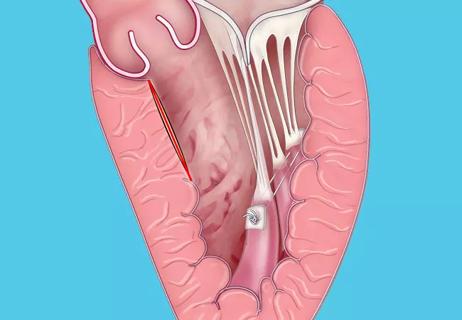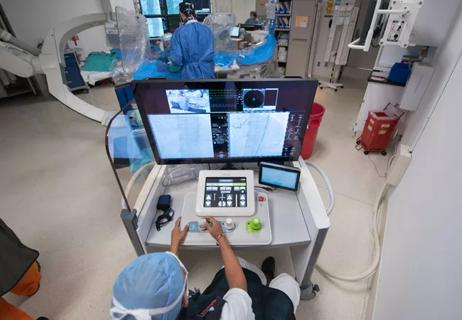Advertisement
Keys to success include a team-based approach and integration into clinical workflow

The availability of personal digital technologies to monitor blood pressure is not enough to impact patient health, noted Cleveland Clinic cardiologist Luke Laffin, MD, in a recent Tall Rounds online CME activity on digital health in cardiovascular medicine. Instead, he argued, physicians must integrate monitoring devices into their practice so that monitoring doesn’t impede workflow and is incorporated effectively with patient education and ancillary healthcare management.
Advertisement
Cleveland Clinic is a non-profit academic medical center. Advertising on our site helps support our mission. We do not endorse non-Cleveland Clinic products or services. Policy
“Managing hypertension is the next big frontier in digital health,” says Dr. Laffin, Director of the Ambulatory Blood Pressure Monitoring Program at Cleveland Clinic. “Not only does digital monitoring save patients time by not requiring so many doctor visits, but it allows for more consistent management and greater patient involvement in maintaining personal health.”
Digital technologies are already established for diagnostics, sensors and wellness activities, but applications to chronic disease management are still being explored and developed, according to Dr. Laffin. The financial implications are large, he adds, as evidenced by the recent $18.5 billion purchase of Livongo, a digital health technology innovator, by Teladoc, a remote patient monitoring company.
The 2017 blood pressure treatment guideline from a multiorganizational task force led by the American College of Cardiology (ACC) and American Heart Association (AHA) recommends home blood pressure monitoring after initiating drug therapy for hypertension (class 1A).
“Regular patient blood pressure monitoring is important, as home and in-office blood pressures can differ significantly,” explains Dr. Laffin, noting that a recent study found that more than one third hypertension patients in a general practice setting had either white-coat hypertension, which can lead to overuse of medications, or “masked hypertension,” characterized by normal measurements in the doctor’s office but otherwise elevated pressures, potentially leading to insufficient therapy.
Advertisement
He adds that patients should be advised not to rely on phone apps for blood pressure monitoring. Multiple validated digital blood pressure monitors are available, with 16 such options listed on an American Medical Association website. Brachial cuffs are preferred, but wrist cuffs can be used in certain circumstances. The FDA has approved a watch-based blood pressure monitor, and validation studies of similar technologies are ongoing.
Studies of various remote blood pressure management strategies have found that several factors increase the chance of success, including the following:
Combining patient monitoring with other interventions. Data obtained from blood pressure measurements must be analyzed by the clinician so that medications can be adjusted as needed. Patient education on promoting a heart-healthy lifestyle is likewise important. These steps have demonstrated efficacy in lowering and controlling blood pressure, with gains persisting for at least a year. “Simply telling the patient to get a digital blood pressure device is inadequate,” Dr. Laffin notes. “A management team must back up home monitoring.”
Integrating remote monitoring into provider workflow. The 2017 ACC/AHA guideline recommends structured, team-based care interventions for hypertension control (class 1A). Physician oversight does not require that doctors regularly examine a patient’s daily blood pressure logs; instead, routine monitoring can be delegated to medical assistants and routine management to nurse practitioners or physician assistants.
A positive patient experience. The device must be easy to use, and remote management should cut down on required office visits.
An appropriate time-to-reimbursement ratio. Tools to increase efficiency include home blood pressure devices that enable patients to directly upload their data into the electronic medical record. This is already available for remote blood pressure monitoring and for blood glucose levels, weight, pulse oximetry readings and activity. Clinicians can set high and low thresholds for flagging.
Billing CPT codes exist for collecting and interpreting digitally stored physiologic data, including specific codes for self-monitoring of blood pressure. While reimbursement is not high, the system makes sense for regular monitoring of multiple patients.
Dr. Laffin points out that a number of ongoing clinical studies are expected to lead to expanded use of remote blood pressure monitoring. He cited two current studies that Cleveland Clinic is involved in.
Advertisement
1) Digital home blood pressure monitoring in type B aortic dissection patients (DISSECT-BP). In this single-center Cleveland Clinic study (NCT04116684), patients with a diagnosis of type B aortic dissection or intramural hematoma who do not receive surgical intervention are being randomized to standard-of-care home blood pressure monitoring or home digital blood pressure monitoring that transmits data to the electronic medical record and includes team management. The primary endpoint is change in mean 24-hour systolic blood pressure over the four-week study period. Additional details are available in a previous ConsultQD post.
2) Feasibility and reproducibility of a watch-type wearable blood pressure monitor during exercise. This study is evaluating a wristwatch monitoring device used by cardiac rehabilitation patients exercising on a stationary bike, with a focus on reproducibility of blood pressure measurements.
“We can expect to see a flourishing of applications of home blood pressure monitoring as technology continues to develop and studies validate different interventions,” says Dr. Laffin. “There are many situations in which increased patient involvement in blood pressure management can potentially have a real impact on health.”
“Uncontrolled hypertension is a silent killer,” adds his colleague Leslie Cho, MD, Co-Section Head of Preventive Cardiology and Rehabilitation at Cleveland Clinic. “Digital blood pressure monitoring can help diagnose and treat patients. It represents an exciting new area for us.”
Advertisement
Advertisement

Patient-patient network analysis proves to be fast and clinically intuitive

How we’re using a new multidisciplinary approach to broaden the benefits of ablation

Models developed with promising accuracy and generalizability to clinical practice

Illustrated case series profiles a valuable tool for a rare and complex entity

A minimally invasive, single-incision approach to two coexisting problems

New review outlines applications to date, hurdles to overcome

A long-overdue technology is poised to reshape practice

A short video portrait and overview of our experience to date